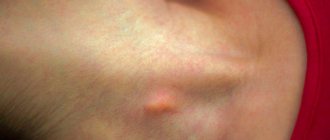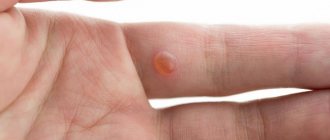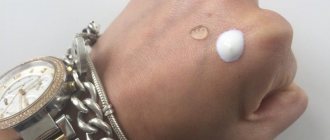Antihistamines are aimed at eliminating allergies in all its manifestations. During their action, the drugs block special receptors that are involved in the development of an allergic reaction. Especially if this is an immediate reaction, where the main role belongs to an organic compound - histamine. Under provoking factors, histamine becomes active in the human body and can lead to such types of allergies as:
- allergic rhinitis;
- allergic conjunctivitis;
- hives;
- angioedema;
- reaction to an insect bite;
- allergies to medications (tablets, sprays, etc.);
- food allergies;
- skin allergies, allergic dermatosis.
Taking an antihistamine (drops, tablets, ointment) in these cases is the first line of treatment. All medications in the form of tablets or drops act on H1 receptors located in the brain, blood vessels, smooth muscles, cardiac tissue, cartilage tissue, etc. [1].
Choosing allergy drops
Allergy drops are considered one of the most effective remedies in the fight against its main symptoms. Their effectiveness in treatment is determined, first of all, by how correctly they are selected. Only your attending physician can determine which type of allergy drops is right for you, and help you choose from an assortment full of names, based on the research and analyzes performed.
It is extremely important to determine what action - antihistamine, vasoconstrictor, immunomodulatory or hormonal action - you need the drug and whether there are any contraindications for using the selected drops.
Moreover, the maximum effect of use is often achieved with the combined use of such a dosage form and tablets.
Definition of drugs
Antihistamine drops are needed to quickly relieve the unpleasant symptoms of an allergic reaction that has occurred in the eyes (itching, conjunctival hyperemia, lacrimation, photophobia, swelling).
There are several main types of antihistamine eye drops:
- Antihistamines (anti-allergic eye drops). They have a rapid anti-allergic effect, therefore, in the acute period of allergic conjunctivitis, they can quickly eliminate itching and stop severe lacrimation. The main active ingredients of antihistamines prevent the release of histamine into the intercellular space and suppress the activity of mast cells, which take part in the development of allergic reactions. Antihistamine drops stabilize the permeability of mast cell membranes and reduce the possibility of cell contact with allergens.
- Anti-inflammatory drops. They are divided into corticosteroid and non-steroidal. Anti-inflammatory eye drops are good at relieving itching and swelling during allergic reactions. It must be remembered that such products must be used carefully and under the supervision of a doctor, since their long-term use can provoke the development of glaucoma, dry eye syndrome, and lens clouding. Such drops are used for infectious-allergic inflammatory processes occurring in the superficial layers of the eyes.
- Vasoconstrictor drops. Such medications reduce swelling and redness of the eyes and reduce the severity of allergy symptoms. Please note that long-term use of vasoconstrictor drops leads to addiction, and when the drug is discontinued, all symptoms return again. Also, such drops are well absorbed through the vessels of the eyes and, entering the bloodstream, affect all organs and tissues of the body.
These drugs can be used either separately or in combination with each other.
Other types of drops that can be used for allergies:
- Mast cell stabilizers. They have a cumulative effect, as they do not act immediately. Stabilizers cause changes in mast cells, from which histamine (one of the main components of allergies) is released.
- Tear substitutes. These drugs moisturize the eyes, which become dry, red and irritated due to allergies. They should be stored in the refrigerator to provide an additional calming effect. Tear substitutes are safe and can be used frequently.
Nuances of selecting drops for children
Children's allergy drops deserve special attention, since it is very important that they not only relieve allergy symptoms, but also do not become highly addictive.
Since infants are allowed only a very limited list of anti-allergy medications than children over one year old, not to mention teenagers, the prescription of medications in this form to small allergy sufferers occurs strictly in accordance with the child’s age group and with a detailed description of how to use them.
When prescribing, special attention is required to contraindications that are not related to the child’s age and which need to be taken into account when making a choice:
The use of antihistamine drugs for abnormalities in the child’s cardiovascular system is unacceptable, since they have a pronounced cardiotoxic effect.
Vasoconstrictor medications should not be used for more than three to five days, as they can cause a strong addiction in the child, which is extremely difficult to get rid of. If you have frequent nosebleeds or injuries, these drops should not be used.
Hormonal and antiviral drugs are prescribed and used as a last resort, since the harm they cause to the child’s body often outweighs the benefits.
Antihistamines for food allergies
A food allergic reaction develops in the body after the irritant enters the digestive tract. Any product can cause an allergic reaction, but more often:
- lactose;
- cow's milk protein;
- egg;
- fish, crayfish and shrimp;
- legumes, peanuts and soybeans;
- cereals;
- tomatoes;
- citruses.
Most often, food allergies occur in young children. This happens due to the immaturity of the digestive tract and lack of tolerance to most substances. It may go away with growing up, so ASIT (allergen-specific immunotherapy) is prescribed only to people in adulthood.
Food allergies are often accompanied by skin manifestations, urticaria, dermatitis, rashes and itchy skin. There is also disruption of the mucous membrane, allergic rhinitis, conjunctivitis, and Quincke's edema.
To treat a food allergy, it is necessary to identify the allergen and eliminate it from the diet. To relieve symptoms, it is recommended to take an antagonist substance that blocks histamine.
It is also advisable to prescribe vasoconstrictor drops for allergic rhinitis due to food allergies.
In case of a systemic allergic reaction to foods, antihistamine tablets are prescribed to avoid anaphylactic shock. In case of acute manifestations, after recovery from anaphylactic shock, a course of treatment with chloropyramine and clemastine is prescribed.
For allergic rhinitis, urticaria and other manifestations of an acute reaction of the body, it is recommended to take antihistamines such as Cetrin®.
The drug is suitable for long-term use. The onset of the effect after a single dose of 10 mg of cetirizine is 20 minutes, lasts more than 24 hours. During the course of treatment, tolerance to the antihistamine effect of cetirizine does not develop. After stopping treatment, the effect lasts up to 3 days5.
Orally, regardless of food intake, without chewing, the tablets are taken with 200 ml of water. Adults – 10 mg (1 tablet) 1 time a day or 5 mg (1/2 tablet) 2 times a day. Children over 6 years old - 5 mg (1/2 tablet) 2 times a day or 10 mg (1 tablet) 1 time a day. In patients with reduced renal function (creatinine clearance 30–49 ml/min), 5 mg/day (1/2 tablet) is prescribed, in severe chronic renal failure (creatinine clearance 10–30 ml/min) – 5 mg/day ( 1/2 tablet) every other day5.
Cetrin® is usually well tolerated. In some cases, possible: drowsiness, dry mouth; rarely - headache, dizziness, migraine, discomfort in the gastrointestinal tract (dyspepsia, abdominal pain, flatulence), allergic reactions (angioedema, rash, urticaria, itching) [4], [5].
Instructions - a sure way not to make mistakes
For the speedy treatment of allergies and their symptoms in any patient, be it an adult or a child, it is very important to follow the instructions for use of the prescribed medication, including allergy drops. They necessarily spell out the main points that need to be paid attention to before use.
To ensure that the drops you use help you and not harm you, pay attention to the following points in the instructions:
- What type of drug is it - what is its effect;
- Contraindications – what age group are the drops aimed at, are there any restrictions for diseases or a complete ban on their use;
- Side effects - only homeopathic medicines do not have side effects or contraindications; in other cases, a list of points in which drops should be used with caution will be reflected in the instructions;
- Method of application - where should the drops be placed - into the eyes or nose and according to what scheme.
Anti-inflammatory drops
Acular
They are a non-steroidal, non-hormonal drug, the active ingredient is ketorolac trometamol. Acular is able to spread quickly and deeply into the tissues of the eye and relieves the symptoms of an acute allergic reaction.
Indications:
- recovery period after operations on the cornea;
- pain, burning, itching and a feeling of “sand” in the eyes.
Contraindications:
- third trimester of pregnancy;
- children under 3 years old;
- chronic gastrointestinal diseases.
Side effects:
- local pain;
- temporary swelling.
The drug can be used together with antibiotics, but it affects wound healing, slowing down tissue regeneration.
Dexamethasone
A fast-acting hormonal drug that can have an anti-inflammatory and anti-allergenic effect just a few hours after use.
Indications:
- postoperative period of restoration of eye tissue;
- blepharitis;
- conjunctivitis;
- keratitis;
- vascular inflammation.
Contraindications:
- infectious and fungal eye diseases;
- glaucoma;
- lactation period.
Side effects:
- fogginess;
- increased pressure inside the eyeball;
- cataract;
- temporary burning sensation.
Dexamethasone should be used only as prescribed by a doctor.
Levomycetin
This drug has a wide spectrum of action. It is able to fight numerous bacteria and infectious allergy pathogens. The active ingredient is chloramphenicol.
Indications:
- eye infections;
- allergic conjunctivitis.
Contraindications:
- liver failure;
- children under 4 months of age.
Side effects:
- itching in the eyelid area;
- increased lacrimation.
Diclofenac
It is a good anesthetic, can be used for non-infectious inflammation in the eye area, promotes rapid tissue healing, and is effective in restoring the retina and treating corneal erosion.
Indications:
- conjunctivitis;
- corneal erosion;
- eyeball injuries;
- constriction of the pupil;
- acute course of non-infectious allergy.
Contraindications:
- children under 2 years old;
- herpetic keratitis during relapse;
- third trimester of pregnancy.
Side effects:
- tissue swelling;
- burning sensation;
- photophobia.
The best drug is the one that helped you
There is no list of the best or worst allergy drops, according to experts. When making a choice, you should not rely on the price of the drug or on the recommendations of friends, since any allergy is individual and requires an individual approach.
The best drops will be those that lead to the elimination of allergies and their symptoms in patients. Recently, antihistamines have become most popular in use, since they are aimed not so much at eliminating symptoms, but at eliminating the cause of their occurrence.
When to apply
Antihistamine drops are used for diseases caused by allergens.
For example, ordinary conjunctivitis is one of the most common allergic diseases. It often occurs under the influence of both external and internal irritating factors.
The main method of treating ophthalmic diseases, which are based on a reaction to a particular substance, are allergy eye drops.
It must be remembered that before choosing a medicine, it is necessary to accurately diagnose the allergic disease.
Allergic eye diseases:
- Papillary conjunctivitis. With this disease, a bump appears on the mucous layer under the upper eyelid. Papillary conjunctivitis is often diagnosed in people who wear contact lenses. Allergies can occur to the lens material or the substance used to treat them.
- Atopic keratoconjunctivitis. It occurs simultaneously with neurodermatitis or in people who have had atopic dermatitis in childhood.
- Contact dermatitis of allergic origin. With this disease, the upper eyelid is affected, it turns red, itches, and eyelashes may fall out. Contact dermatitis is often diagnosed in women because allergies can occur to mascara.
- Spring conjunctivitis. It is typical for people living in areas with windy and dusty weather. With spring conjunctivitis, the eyes swell, there is lacrimation and photophobia, and a sticky discharge appears.
- Drug eye allergies. It is accompanied by swelling, itching and lacrimation.
Glaucoma drops Tapticom
Contact lenses for 6 months: types, brands, features of use are described in this article.
Tinted lenses for eyes https://eyesdocs.ru/linzy/s-dioptriyami/ottenochnye-kontaktnye-dlya-glaz.html
Photo of allergy drops
TOP 5 naturally occurring antihistamines to combat allergies
Author: Taras Anatolyevich Nevelichuk
Last modified: 2020-08-6 Date written: 2019-06-24
People with allergies can relieve symptoms with natural plant extracts and products that act similar to antihistamines.
Antihistamines are substances that block the activity of histamine in the body. Histamine is a protein that causes allergy symptoms such as sneezing, itchy eyes and a scratchy throat.
Over-the-counter and prescription antihistamines are effective in relieving allergy symptoms, but may cause side effects such as drowsiness and nausea. As a result, some people want to try natural alternatives.
In this article, we will talk about the five best natural antihistamines and look at their properties from a scientific point of view.
Vitamin C
There are a number of natural antihistamines that can help relieve allergy symptoms.
Vitamin C strengthens the immune system. It also acts as a natural antihistamine.
Oxidative stress plays a key role in allergic diseases, according to a 2020 study on vitamin C in allergy treatment. Because vitamin C is a powerful antioxidant and anti-inflammatory, it can act as an allergy reliever.
The researchers noted that high doses of vitamin C given intravenously relieved allergy symptoms. They also found that a lack of vitamin C can lead to the development of allergic diseases.
Another study from 2000 suggested taking 2 grams of vitamin C per day as an antihistamine.
Vitamin C is present in many fruits and vegetables, including:
- Bell pepper
- broccoli
- cantaloupe
- cauliflower
- citrus
- kiwi
- strawberries
- tomatoes and tomato juice
- winter squash
Dietary supplements containing vitamin C, with and without bioflavonoids, are sold in pharmacies and online stores.
Butterbur Extract (Butterbur)
Butterbur is a plant extract from the Butterbur shrub (Petasites hybridus), which grows in Asia, Europe and parts of North America. People often use butterbur to treat migraines and hay fever, also known as allergic rhinitis.
According to the National Center for Complementary and Integral Health (USA), butterbur extract may have an antihistamine effect.
A 2007 review of 16 randomized controlled trials testing 10 herbal products found that Butterbur may be an effective herbal remedy for hay fever.
This review demonstrated that butterbur relieved allergy symptoms better than placebo or as effectively as antihistamines.
However, the review authors note that some large studies were funded by industrial manufacturers and therefore further independent research is needed.
According to the National Center for Complementary and Integral Health, butterbur extract is well tolerated by most people, but it can still cause side effects, including:
- labored breathing
- diarrhea
- drowsiness
- fatigue
- headache
- itchy eyes
Raw butterbur extract contains certain compounds called alkaloids, which can cause liver damage and cancer. Butterbur extracts are commercially available that do not contain these substances. However, no studies have looked at the long-term effects of taking these drugs.
The plant extract may also cause allergic reactions in people with hypersensitivity to ragweed, chrysanthemums, calendula and daisies.
Bromelain
Pineapple juice contains the anti-inflammatory enzyme bromelain
Bromelain is an enzyme found in the pulp and juice of pineapples and is also available as a dietary supplement.
Bromelain is a popular natural remedy for swelling or inflammation, especially in the sinuses and after injury or surgery.
Studies in mice have demonstrated that bromelain can reduce allergic sensitization and alleviate the symptoms of allergic airway diseases due to its anti-inflammatory and antiallergic properties.
In some people, taking bromelain supplements may cause adverse reactions, such as:
- menstrual cycle changes
- indigestion
- cardiopalmus
People who are allergic to pineapple should avoid bromelain.
Dietary supplements containing bromelain are available in pharmacies and online stores.
Probiotics
Probiotics are microorganisms that may provide health benefits by helping to maintain a healthy balance of bacteria in the gut.
Probiotics can strengthen a person's immune system, which can help the body fight allergies.
The National Center for Complementary and Integral Health (USA) argues that all the evidence for the effectiveness of probiotics is mixed together, and that some may be beneficial and others may not.
Quercetin
Quercetin is an antioxidant flavonoid found in many plants and foods. Scientific research suggests that adding quercetin to your diet may help relieve allergy symptoms.
According to these data, quercetin may have antiallergic and antihistamine properties.
In one animal study, researchers found that quercetin could reduce the respiratory effects of allergies in mice by reducing airway inflammation.
However, evidence of its effectiveness is mixed, and according to the National Center for Complementary and Integral Health (USA), there is not enough scientific evidence that quercetin can relieve allergic rhinitis.
Quercetin is present in many foods and herbs, including:
- apples
- berries
- Black tea
- broccoli
- buckwheat tea
- grape
- Ginkgo biloba
- green tea
- pepper
- Red onion
- red wine
However, taking dietary supplements containing quercetin will be more effective in relieving allergy symptoms than eating foods that contain it. This is because the foods contain significantly lower levels of flavonoids.
Quercetin is generally safe for most people. This may cause headaches and tingling in the arms and legs in some people. Very high doses, especially if taken long term, can cause kidney damage.
People can buy quercetin supplements from pharmacies or online stores.
Other natural allergy remedies
The National Center for Complementary and Integral Health (USA) states that there is insufficient evidence that the following naturally occurring remedies can help with symptoms of allergic rhinitis:
- astragalus
- grape seed extract
- omega-3 fatty acids
- nettle
- pycnogenol
- spirulina
Alternative Allergy Treatments
If natural antihistamines do not reduce a person's allergy symptoms, they may need alternative treatment options.
Other methods of treating and preventing allergy symptoms include:
Avoiding contact with the allergen
Avoiding contact with the allergen is usually the first line of defense against the onset of symptoms. Try to identify the allergen, which could be pollen, pet dander, or mold spores, and reduce your exposure to it as much as possible.
Medicines
Drug therapy can weaken the immune system's response to the allergen. Antihistamines destroy histamine produced in the body.
Antihistamines can relieve symptoms such as sneezing, itchy eyes, and pressure in the sinuses.
There are both prescription and over-the-counter allergy medications that include:
- oral medications
- solutions for internal use
- nasal sprays
- eye drops
Immunotherapy
Immunotherapy may be helpful for people with severe allergies
People with severe allergies may benefit from immunotherapy. This treatment is also suitable if allergy medications do not relieve your symptoms.
During immunotherapy, a healthcare professional gives a person a series of injections containing a small amount of the allergen. This treatment can last for several years and is aimed at reducing the body's sensitivity to the allergen.
For people with pollen allergies, doctors may recommend sublingual immunotherapy. This method consists of placing the tablet under the tongue until it is completely absorbed.
Treatment with adrenaline
People with severe allergies may need to carry an epinephrine auto-injector (Auvi-Q, EpiPen) with them at all times. Administration of this drug at the onset of an allergic reaction can reduce symptoms and save a person's life.
conclusions
Living with allergies can be challenging, especially when symptoms are severe. In such cases, it is best to seek help and advice from a doctor.
Some natural substances may have antihistamine properties, meaning they can break down the chemicals (histamine) that cause allergy symptoms. More research is needed to find out how effective these natural remedies are.
For the most effective symptom relief, try limiting or avoiding exposure to the allergen. Practice good hygiene and a healthy lifestyle, and consider using natural antihistamines.
Before taking any dietary supplements or herbal remedies, you should consult your physician as their manufacture and content may not be regulated by government drug regulatory authorities although they may affect the effects of certain medications.











